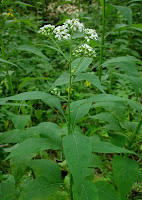 |
| Frost Flowers- click to enlarge |
 |
| White Crownbeard |
Another common plant producing them is Yellow Ironweed, (Verbesina alternifolia) which can grow to higher than 9 feet tall. It also has distinctive wings along its stalk, making it easy to identify. For you botanists, there are other plants producing frost flowers include Dittany (Cunila origanoides), Hoary Frostweed (Helianthemum bickmellii), Helianthemum canadense, Pluchea odorata, P. foetida, and P. camphorata.
 |
| Verbesina - winged stem |
Frost flowers* are ribbons of ice which split the winged stems of these wildflowers as the sap freezes. The spirals may extend more than eight inches up the stem or curl around the base in complex rosettes up to 8" in diameter. The individual ribbons are so thin that you can see your fingerprint through them. They sometimes recur as small basal collections after a third or fourth frost, so keep looking.
There is more than you could ever remember about frost flowers at this comprehensive University of Texas site.
Pictures are from http://www.missouriplants.com/ which supplies excellent descriptions.
* Other names include ice ribbons, ice flowers, ice fringes, ice fingers, ice filaments, ice leaves, frost ribbons, frost freaks, frost beards, frost castles (Forrest M. Mims III http://www.forrestmims.org/gallery.html), and crystallofolia.
